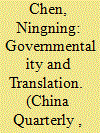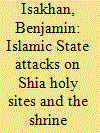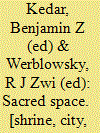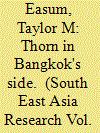|
|
|
Sort Order |
|
|
|
Items / Page
|
|
|
|
|
|
|
| Srl | Item |
| 1 |
ID:
181137


|
|
|
|
|
| Summary/Abstract |
This paper explores the cultural politics of lineage landscapes in contemporary rural China. Drawing on a combined governmentality/translation approach and ethnographic fieldwork in rural Wenzhou, it examines how the state governs the production of lineage landscapes and how local lineages translate governmental technologies in complex ways. Empirical evidence reveals that the government develops diversified rationalities and modes of governance to direct the (re)construction of lineage landscapes. It is also found that local lineages are skilled at appropriating state discourses and practices as well as enrolling other (non-)human actors, thereby legitimizing their landscape projects of ancestral tombs and memorials. On the ground, they often displace state objectives with the production of their preferred landscape (for example, “chair” tombs). Respectful of ancestors, state agents sometimes turn a blind eye to local displacement; however, while encountering challenges from the higher-level government, they intensify regulation, but lineages still retain the capacity to negotiate with them. With sensitivity to the entanglement of diversified actors and their dynamic interactions, this paper underlines the multiplicity and contingency of state governance and societal responses. It also foregrounds the cultural politics of lineage landscapes as a process of translating governmental technologies characterized by continuous mobilization, displacement and negotiation in a heterogeneous network.
|
|
|
|
|
|
|
|
|
|
|
|
|
|
|
|
| 2 |
ID:
172197


|
|
|
|
|
| Summary/Abstract |
After conquering large swaths of Syria and Iraq, the IS undertook an aggressive sectarian campaign in which they not only enacted horrific violence against the Shia people, but also damaged or destroyed several key Shia mosques and shrines. Drawing on Social Movement Theory (SMT), this article analyzes the response by various Shia non-state actors—militia leaders, religious clergymen, populist preachers, and seminal poets. It argues that they used the IS threat to Shia holy sites to develop and deploy a mobilization frame that has come to be referred to as the “shrine protection narrative.” The article also documents the manifold consequences of the shrine protection narrative: it underpinned a mass recruitment drive that saw tens of thousands enlist; it legitimized foreign Shia militias to enter the conflicts in both Syria and Iraq; it justified the formation of entirely new militias who declared the centrality of shrine protection to their mandate; and it mobilized them to enact political violence. In doing so, this article extends existing studies of SMT to demonstrate that “sacred spaces”—and particularly the need to protect religious sites from specific threats—can serve as a powerful mobilization frame towards political violence.
|
|
|
|
|
|
|
|
|
|
|
|
|
|
|
|
| 3 |
ID:
049325


|
|
|
|
|
| Publication |
Hampshire, macmillan Press, 1998.
|
| Description |
348p.
|
| Contents |
Proceedings of the International Conference in Memory of Joshua Prawer
|
| Standard Number |
9780333661291
|
|
|
|
|
|
|
|
|
|
|
|
Copies: C:1/I:0,R:0,Q:0
Circulation
| Accession# | Call# | Current Location | Status | Policy | Location |
| 040075 | 291.35/KED 040075 | Main | On Shelf | General | |
|
|
|
|
| 4 |
ID:
122905


|
|
|
|
|
| Publication |
2013.
|
| Summary/Abstract |
Scholarship on the integration of Siam's northern periphery has largely overlooked the role of sacred space in the transition to modernity. While Lanna had been politically and economically integrated into modern Siam, sacred space remained a contested point of articulation between local elites and Bangkok officials long into the twentieth century. Khruba Sriwichai's movement to restore sacred spaces throughout the region shows not only how resistance to Siam continued well after the political-economic integration of the region, but also how this resistance drew on the legacy of sacro-spatial legitimacy, once a crucial part of the pre-modern Chiang Mai state.
|
|
|
|
|
|
|
|
|
|
|
|
|
|
|
|
|
|
|
|
|